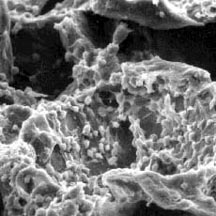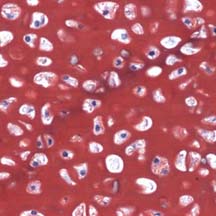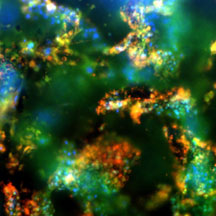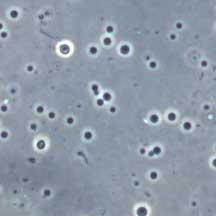 |
|
I. Fundamental Polymer Design and Development II. Musculoskeletal Tissue Engineering III. Controlling Stem Cells with Material Cues IV. Controlled Molecule Delivery |
The overall focus of the research in the Burdick Polymeric Biomaterials Laboratory is the fundamental understanding and development of polymeric materials for biomedical applications with a specific emphasis on tissue regeneration and drug delivery. Although significant advances in tissue engineering have been made in recent years, the continued lack of organs and tissue for transplantation calls for the development of innovative treatment alternatives. Advances in synthetic chemistry and materials processing may be the answer to meeting this organ and tissue shortage. The research in my laboratory involves: (i) developing novel synthetic polymeric materials and precursors that are both biocompatible and degradable; (ii) utilizing processing techniques to fabricate scaffolds with the desired micro- and macroscopic structures both spatially and temporally; (iii) investigating the interaction of cells with these materials while developing materials-based techniques to control cell differentiation; and (iv) using synthetic polymers to control the delivery of therapeutic molecules. The platform for ongoing projects in the laboratory is the use of either radical polymerizations (either photo or redox initiated) or self-assembly for material fabrication. Additionally, we are interested in stimuli-responsive materials, where external triggers can be used to modify material properties. To this end, the following topics are currently being investigated in my laboratory. |
| I. Fundamental Polymer Design and Development |
 |
Concurrently with the development of translational biomaterials relevant for therapeutic applications, we are interested in learning more about how monomer/macromer chemistry (e.g., type of degradable groups, hydrophobicity) and structure (e.g., molecular weight, branching, number of functional groups) influence both network formation and the resulting physical properties (e.g., degradation, mechanics) of the polymerized networks. One specific project involves the development of injectable materials that have tunable properties and can be used for the repair of cardiac tissues. |
| Return to Top
|
| II. Musculoskeletal Tissue Engineering |
 |
Our work in musculoskeletal tissue engineering is towards the regeneration of cartilage, bone, and meniscus tissues. Each of these tissues has specific design requirements that must be taken into consideration, as well as the potential cellular source. For cartilage, we are developing hydrogels that can provide both structural and chemical cues to encapsulated cells, whereas acellular macroporous scaffolds that deliver growth factors are being engineered for bone regeneration. Due to the fibrous nature and directionality of meniscus, fibrous scaffolds are being designed that incorporate the appropriate temporal elements to optimize tissue formation and cellular infiltration. |
| Return to Top
|
| III. Controlling Stem Cells with Material Cues |
 |
Our laboratory is also interested in the development of materials for the encapsulation of stem cells and the utilization of material-based techniques to control stem cell differentiation. We have found that the chemical structure of the material can dictate the differentiation (or lack of) of an entrapped stem cell. Due to our spatial control with these photoinitiated polymerizations, we can also control material structure and properties spatially to control stem cell differentiation in patterns. Through controlled degradation of networks, these cues can also be used for temporal differentiation. |
| Return to Top
|
| IV. Controlled Molecule Delivery |
 |
Novel polymers may be particularly useful towards the controlled delivery of a variety of therapeutic molecules. This may include macromolecular assemblies, such as vesicles, or bulk polymers, where molecule release is linked to the network structure and degradation. Our efforts are to better control local molecule delivery through advanced polymer design and utilizing polymer structural changes under various triggers to mediate delivery. Many of these techniques may be combined with imaging techniques for multifunctional applications. |
| Return to Top |
|
Department of Bioengineering |